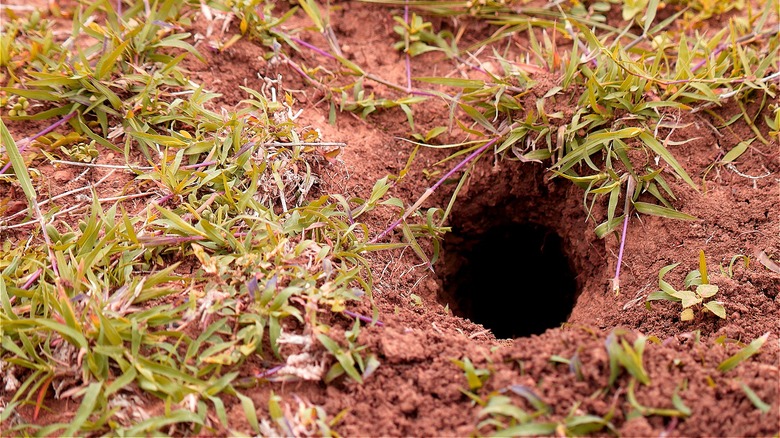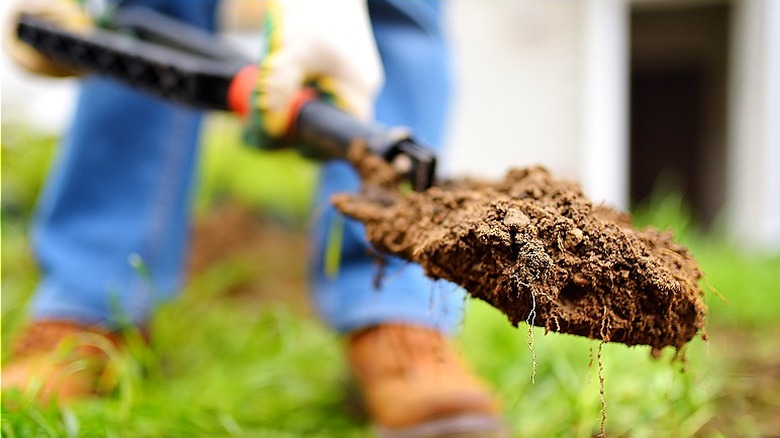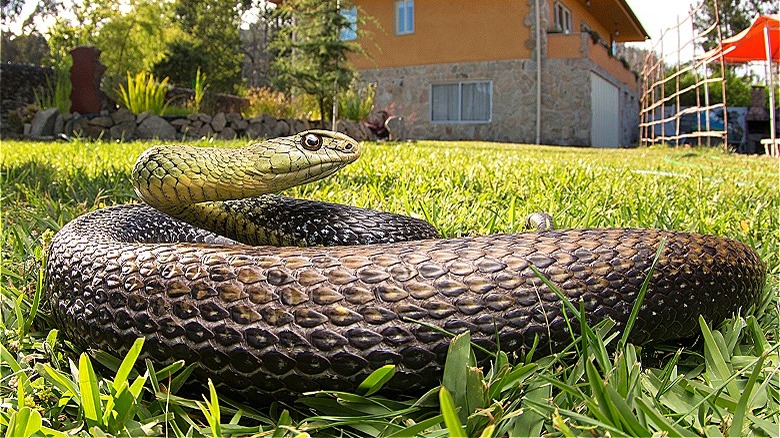How To Deal With Snake Holes In Your Yard
Finding any type of hole in your yard is disturbing enough, but determining that a snake may have tunneled into your property fuels next-level anxiety. Granted, the slithery creatures aren't equipped to perform the excavation job on their own. However, they're more than adept at taking advantage of a shaft created by a rodent or other burrowing critter. Consequently, it pays to craft an effective plan to deal with snake holes marring your landscape. Fortunately, erasing the unsightly openings simply requires evicting, filling, and making your garden as inhospitable to snakes as possible.
Snakes aren't especially picky when it comes to their home's building material. They will happily inhabit holes made in grass, dirt, sand, and under sticks. This makes it challenging to know with absolute certainty if the hole you suspect is harboring a snake is in fact doing so. The easiest way to identify a snake hole is if you actually see a serpent gliding in or out of it. If you haven't, use a stick to check for vacancy or install a camera to document the hole's resident.
Another option is to look for freshly shed snake skin or feces. The latter is dark, firm, and tubular in shape with intermittent white powdery streaks and may contain bones and fur. If neither skin nor excrement is visible, check for debris or spiderwebs in and around the hole. Any natural matter obstructing a tunnel's entry may signal that it hasn't been used in a while.
Tips for filling and covering snake holes
Even after exhausting the aforementioned steps, there's a chance you may not be able to fully ascertain whether or not the hole(s) in your yard are snake-related. To be safe, err on the side of caution and assume they are, especially if you have pets and children who enjoy playing outside. Your goal now is to get rid of the gaps in your yard by filling and covering them.
Start the process by using a small shovel to smash dirt firmly into the opening. Compacted soil and stones can also be combined to fill holes provided you securely pack them down as you plug the space. Another option is to stuff steel wool into the pit as its density inhibits a snake's ability to move. Moreover, the limbless reptiles are unable to chew through it. Just remember, regardless of the fill you select, it's important to carefully monitor your progress. You want to make sure the materials you use to fill the crater are flat or as level as possible with the ground.
Alternatively, you can use wire fencing, netting, burlap, or wood boards to cover snake holes. However, using too many materials may provide the sneaky vermin with another housing option. When creating a lid for the opening, use only enough of the medium as necessary. Layering an excessive amount of burlap or boards over a hole will simply create an ideal space for snakes to nest.
How to make your yard inhospitable to snake holes
Making snake holes as uninviting as possible is the best way to preserve your property. Begin with a simple trick that helps keep snakes out of your garden — sharp mulch. Covering the ground with jagged chunks of wood that can injure their bellies is a simple and effective serpent deterrent. Another natural weapon is cinnamon. Strategically place cinnamon sticks or oil in areas where you have plugged holes. The popular scent keeps snakes out of your yard and garden as the sneaky reptiles find the odor repulsive.
In addition, don't roll out the red carpet for cunning serpents by making your yard a snake Shangri-La. Snakes stick close to any area that provides them with a dependable source of food. Consequently, if your yard features tall grass littered with dry leaves and sticks that shelter insects and rodents, you're creating the perfect environment for snake occupation. It doesn't matter if you filled snake holes in your garden, the reptiles will return to your property if they know it's hosting their favorite foods and housing the very creatures digging their homes.
You can make your yard less attractive to snakes by eliminating piles of dirt and rocks, removing bundles of firewood, placing trash in pest-resistant garbage bins, and refraining from leaving uneaten pet food outdoors. Finally, if all else fails, including placing metal or glue traps in spots where holes exist, call a professional pest control company for help.


